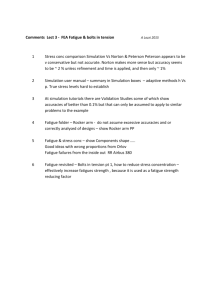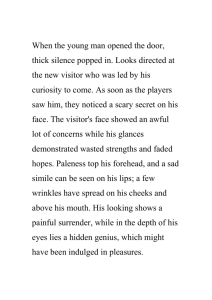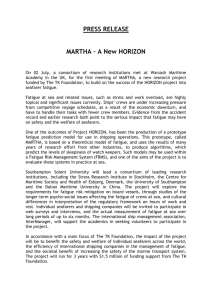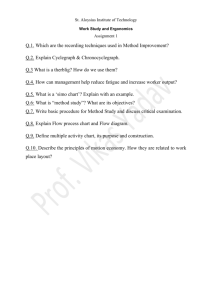Health-Related Quality of Life in Outcome Studies
advertisement
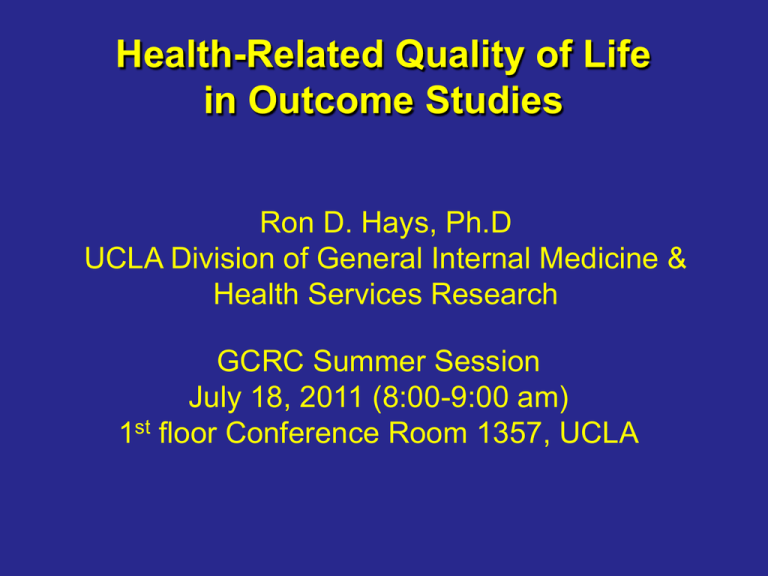
Health-Related Quality of Life in Outcome Studies Ron D. Hays, Ph.D UCLA Division of General Internal Medicine & Health Services Research GCRC Summer Session July 18, 2011 (8:00-9:00 am) 1st floor Conference Room 1357, UCLA Health-Related Quality of Life is … What you can do. • Functioning Self-care Role Social How you feel about your life. • Well-being Emotional well-being Pain Energy The Tower of Babel (Brueghel, 1563) 4 Physical functioning (10 items) Role limitations/physical (4 items) Role limitations/emotional (3 items) Social functioning (2 items) Emotional well-being (5 items) Energy/fatigue (4 items) Pain (2 items) General health perceptions (5 items) 5 Patient-Reported Outcomes Measurement Information System (PROMIS), 2004-? • An answer to the “Tower of Babel” • A commitment of NIH to improve and standardize measurement of patientreported outcomes (i.e., healthrelated quality of life) PROMIS-1 Network: 2004-2009 ● University of Washington Northwestern ♥ ● Stanford ● Stony Brook ● University of Pittsburgh ● NIH UNC –Chapel Hill ●● Duke University* ♥Coordinating Center Patient Focus Groups Literature Review Expert Input and Consensus Existing Items Newly Written Items Item Pool Expert Review Questionnaire administered to large representative sample Secondary Data Analysis 2.5 2.0 0.8 Psychometric Testing 0.6 0.4 0.2 Information Probability of Response 1.0 Cognitive Testing Translation 1.5 1.0 0.5 0.0 0.0 -3 -2 -1 0 1 2 3 -3 Item Bank (IRT-calibrated items) Short Form Instruments -2 -1 0 1 2 Theta Theta CAT 3 50 Physical Functioning Item Bank Item Item Item Item Item Item Item Item Item Item 1 2 3 4 5 6 7 8 9 n •Are you able to get in and out of bed? •Are you able to stand without losing your balance for 1 minute? •Are you able to walk from one room to another? •Are you able to walk a block on flat ground? •Are you able to run or jog for two miles? •Are you able to run five miles? Computerized Adaptive Testing (CAT) • Select questions based on a person’s response to previously administered questions. • Iteratively estimate a person’s location on a domain (e.g., fatigue, depressive symptoms) • Administer most informative items • Desired level of precision can be obtained using the minimal possible number of questions. Reliability and SEM • z-score (mean = 0 and SD = 1) • T-score = (z-score * 10) + 50 – Reliability = 1 – SEM2 (for z-scores) = 0.91 (when SEM = 0.30) = 0.90 (when SEM = 0.32) • With 0.90 reliability – 95% Confidence Interval for score at mean • z-score: - 0.62 0.62 • T-score: 43.8 56.2 • www.nihpromis.org CAT assessments can achieve higher precision than fixed forms measurement precision (standard error) 0.6 5 0.5 SF-12 items 4 0.4 SF-36 items SE = 3.2 rel = 0.90 3 0.3 HAQ items SE = 2.2 rel = 0.95 2 0.2 CAT 10 items Full Item Bank 1 0.1 rheumatoid arthritis patients representative sample 0 0 10 10 20 20 30 30 40 40 50 50 60 60 70 70 normed theta values Rose et al, J Clin Epidemiol 2007 (accepted) US-Representative Sample 80 8 6 4 Anxiety Mental Depression Fatigue Pain Interference Physical Sleep Disturbance Physical Function Social Social Role Interpretation Person Fatigue Score Low High Likely Q Q QQ QQQQQQ QQQQQ Q Q Q Q Q Q Q Q Unlikely Q Q QQ Q Q Q “I get tired Q Q QQ Q Q QQ Q Q Q “I get tired Q Q Q Q Q Q Q when I run when I get Q Q Q a marathon” out of a chair” Item Location Interpretation Aids Low 30 40 50 60 M = 50, SD = 10 T = (z * 10) + 50 70 High Example of high fatigue Fatigue Score=60 Low 30 40 50 60 High 70 This patient’s fatigue score is 60, significantly worse than average (50). People who score 60 on fatigue tend to answer questions as follows: …”I have been too tired to climb one flight of stairs: VERY MUCH …”I have had enough energy to go out with my family: A LITTLE BIT Example of low fatigue Fatigue Score=40 Low 30 40 50 60 High 70 This patient’s fatigue score is 40, significantly better than average (50). People who score 40 on fatigue tend to answer questions as follows: …”I have been too tired to climb one flight of stairs: NOT AT ALL …”I have had enough energy to go out with my family: VERY MUCH Significant Improvement in all but 1 of SF-36 Scales (Change is in T-score metric) Change t-test prob. PF-10 1.7 2.38 .0208 RP-4 4.1 3.81 .0004 BP-2 3.6 2.59 .0125 GH-5 2.4 2.86 .0061 EN-4 5.1 4.33 .0001 SF-2 4.7 3.51 .0009 RE-3 1.5 0.96 .3400 EWB-5 4.3 3.20 .0023 PCS 2.8 3.23 .0021 MCS 3.9 2.82 .0067 26 Defining a Responder: Reliable Change Index (RCI) X 2 X1 ( 2 ) ( SEM ) SEM SDbl 1 rxx Note: SDbl = standard deviation at baseline rxx = reliability 27 Amount of Change in Observed Score Needed for Significant Individual Change Scale Change Effect size Reliability PF-10 8.4 0.67 0.94 RP-4 8.4 0.72 0.93 BP-2 10.4 1.01 0.87 GH-5 13.0 1.13 0.83 EN-4 12.8 1.33 0.77 SF-2 13.8 1.07 0.85 RE-3 9.7 0.71 0.94 13.4 1.26 0.79 PCS 7.1 0.62 0.94 MCS 9.7 0.73 0.93 EWB-5 28 7-31% of People in Sample Improve Significantly % Improving % Declining Difference PF-10 13% 2% + 11% RP-4 31% 2% + 29% BP-2 22% 7% + 15% GH-5 7% 0% + 7% EN-4 9% 2% + 7% SF-2 17% 4% + 13% RE-3 15% 15% 0% EWB-5 19% 4% + 15% PCS 24% 7% + 17% MCS 22% 11% + 11% 29 Questions?


